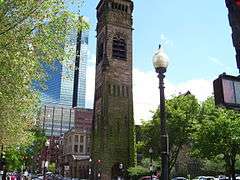First Baptist Church (Boston, Massachusetts)
|
First Baptist Church | |
 | |
| Location | Boston, Massachusetts |
|---|---|
| Coordinates | 42°21′6″N 71°4′36″W / 42.35167°N 71.07667°WCoordinates: 42°21′6″N 71°4′36″W / 42.35167°N 71.07667°W |
| Built | 1872 |
| Architect | Henry Hobson Richardson; Frédéric Auguste Bartholdi |
| Architectural style | Richardsonian Romanesque |
| Part of | Back Bay Historic District (#73001948) |
| NRHP Reference # | 72000146[1] |
| Significant dates | |
| Added to NRHP | February 23, 1972 |
| Designated CP | August 14, 1973 |


The First Baptist Church (or "Brattle Square Church") is an historic American Baptist Churches USA congregation, established in 1665. It is one of the oldest Baptist churches in the United States. It first met secretly in members homes, and the doors of the first church were nailed shut by a decree from the Puritans. The church was forced to move to Noddle's Island. The church was forced to be disguised as a tavern and members traveled by water to worship. Rev. Dr. Stillman led the church in the North End for around 40 years. The church moved to Beacon Hill, where it was the tallest steeple in the city and nicknamed the "Church of the Holy Toothpick". After a slow demise under Rev. Dr. Rollin Heber Neale, the church briefly joined with the Shawmut Ave. Church, and the Warren Avenue Tabernacle, and merged and bought the current church in 1881, for $100,000.00. Since 1882 it has been located at the corner of Commonwealth Avenue and Clarendon Street in the Back Bay. The interior is a pending Boston Landmark.
History
1665–1837
The congregation was founded in 1665 despite a Massachusetts law prohibiting opposition to infant baptism. Many of the early members of the church were persecuted and imprisoned by the state church for heresy, including the first pastor, Thomas Gould. Shortly before the founding of the church, the first Harvard College president, Henry Dunster, was forced to resign his position for refusing to baptize his infant. Dunster had been theologically influenced by Dr. John Clarke and other Rhode Island Baptists persecuted in Massachusetts.[2] During King Philip's War, John Myles pastored the church while on hiatus from the First Baptist Church in Swansea, which was the first church in the state. "In 1679, the Boston Baptists built a meetinghouse in the North End of Boston, at the corner of Salem and Stillman Streets. ...In the early 1700s, the small building was replaced by a larger wooden one on the same site. Here the Church flourished, for 43 years (1764–1807) under the leadership of Samuel Stillman."[2] Samuel Stillman kept the doors open for services while the British invaded Boston and is said to have preached against them every single service.
1837–1882
In 1837 the First Baptist congregation moved into a new brick church building (fourth meeting house) on the corner of Hanover Street and Union Street. Preachers included Rollin Heber Neale.[3] The congregation remained at this location until 1882.[2][4]
1882–present
The current church building (fifth meeting house) was constructed in 1869-1871 by the notable architect Henry Hobson Richardson. It opened in 1872 to serve the Unitarian congregation of the Brattle Street Church, also known as the Church in Brattle Square, which had been demolished in 1872.[5] The Unitarian congregation dissolved soon after moving to this building.[6] The First Baptist congregation bought the building in 1881 for a sum of $100,000/00. The historic and prominent tower with distinctive friezes carved "in-situ" by Frédéric Auguste Bartholdi (sculptor of the Statue of Liberty) representing four sacraments, with faces of famous Bostonians (including Longfellow and Hawthorne), Abraham Lincoln, and Bartholdi's friends of that era, (including 'Garibaldi'). This building was H. H. Richardson's first church before he designed his masterpiece Trinity Church, The Baptist Church's tower can clearly be seen as part of Boston's skyline when viewed from the Cambridge side of the Charles river. This church was added to the National Register of Historic Places in 1972. The congregation is affiliated with the American Baptist Churches USA. The church has a magnificent silver collection at the Boston Museum of Fine Arts. The church is active and on renewal, with many megers, in its 350 years of historyl Donations to restore the Richardson/Bartholdi tower and Clarendon Stree facade may be sent to Dr. Henry P. Henderson,Treasurer and made out to First Baptist Boston, at 110 Commonwealth Avenue, Boston, MA 02116.
See also
References
- ↑ National Park Service (2008-04-15). "National Register Information System". National Register of Historic Places. National Park Service.
- 1 2 3 http://www.firstbaptistchurchofboston.org/history/history.html
- ↑ "Boston Pulpit". Gleasons Pictorial. Boston, Mass. 5. 1853.
- ↑ Boston Directory. 1850
- ↑ Detwiller, Frederic C. (Winter–Spring 1979). "Thomas Dawes's Church in Brattle Square" (PDF). Old-Time New England. Boston: Society for the Preservation of New England Antiquities. 69 (255).
- ↑ "Church in Brattle Square (Boston, Mass.) Records (bMS 1): Register". Harvard University Library. 1969. Retrieved 2009-10-18.
Further reading
- Rollin Heber Neale. An address delivered on the two hundredth anniversary of the organization of the First Baptist church, Boston, June 7, 1865. Gould and Lincoln, 1865.
- Nathan Eusebius Wood. The history of the First Baptist Church of Boston (1665–1899). American Baptist Publication Society, 1899.
External links
| Wikimedia Commons has media related to First Baptist Church (Boston, Massachusetts). |
